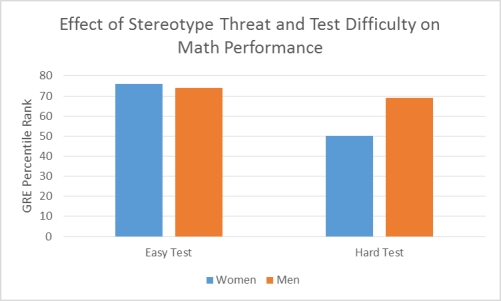Use the following to answer questions
Scenario III
Scenario III is based on fabricated data inspired by the following study:
Spencer, S. J., Steele, C. M. & Quinn, D. M. (1999) . Stereotype threat and women's math performance. Journal of Experimental Social Psychology, 35, 4-28.
Effect of Stereotype Threat on Math Study
The myth that men outperform women in math is widely believed by many individuals. The purpose of the study described in Scenario III was to determine if a sample of women whose math abilities equaled a sample of men would fall victim to this threat. To that end, 28 adult men and 28 adult women were administered an easy math test or a difficult math test. The performance of men and women on both the easy and hard test was quantified. A two-factor ANOVA revealed a significant main effect for test, with participants scoring significantly better on the easy test. The analyses also revealed a main effect for sex, with men performing significantly better than women. The interaction between test difficulty and sex was also statistically significant. Further inspection of the data revealed that although men and women did not differ on the easy math test, women performed significantly less well than men on the difficult math test. Given that the screening criteria for participants including earning a grade of B or better in college calculus, and scoring in at least the 85th percentile on the math subsection of the ACT, the current study indicates that women do succumb to math stereotype threat but only when the math challenge is great. The data are presented in Figure 2.
 Figure 2. Although women and men performed equally on an easy version of the math test, women performed significantly worse than men on the difficult version.
Figure 2. Although women and men performed equally on an easy version of the math test, women performed significantly worse than men on the difficult version.
-(Scenario III) Suppose the researchers described in Scenario III added a third level of difficulty to the math test and added a third variable (time to complete test) . Participants were given 1 hour, 2 hours, or 3 hours to complete the test. This design would now produce how many unique treatment conditions?
Definitions:
Managerial Ethics
Principles and standards that guide behavior in the world of business, including fairness, honesty, and integrity.
Corporate Social Responsibility
The concept that businesses should be accountable for their impact on society and the environment, going beyond profit-making to ethical, social, and ecological concerns.
Mary Parker Follett
An early 20th-century social worker and management consultant who emphasized the importance of human relations and collaborative management in organizations.
Maslow
A theory of human motivation that suggests people are motivated by a hierarchy of needs, starting from basic physiological needs to self-actualization.
Q1: Malica recently completed an experiment that revealed
Q6: What are the benefits of using a
Q11: Ron completed a study on personality variables
Q18: Most hominin fossil finds have come from
Q37: Randall is interested in using his psychology
Q46: Mr.Miles is a young entrepreneur who recently
Q52: The Rosenberg self-esteem scale was used in
Q53: If Dr.Prime is specifically interested the general
Q65: Some forms of cultural anthropology overlap with
Q67: Rynkrd Properties has a fairly simple organizational